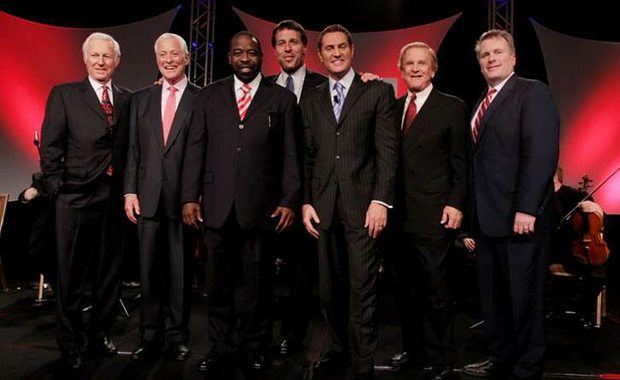Success Advice
12 Brilliant Business Ideas Taken From Famous Rock Stars

Business is a lot more fun when you learn from rock stars instead of text books. If your ears are open, you’ll find that many essential business lessons are coming through your speakers. Turn it up to “11” and sing along to the 12 Most Compelling Business Lessons from Rock Stars, adapted from the pages of the book “Brand Like A Rock Star: Lessons From Rock ‘n’ Roll To Make Your Business Rich and Famous.”
Rock Star Business Lessons
1. Be as unique as KISS
There was nobody like them. They wore elaborate make-up, spit blood, breathed fire, and blew stuff up on stage. Because of that, they got noticed. Getting noticed is the first critical step in marketing. If you don’t get noticed, you don’t exist… and you’ll never have the chance to prove to anyone how great you are.
2. Be as consistent as AC/DC
Every album has the same iconic font. Every picture of the band has Angus wearing a school boy outfit. And they never sing about starving children in the third world or the angst of a relationship that ends badly. If your business isn’t consistent, people will never know what to really expect from you.
3. Be as hated as Nickelback
The whole world hates Nickelback. Yet they’ve sold over 50 million albums and continue to sell out concerts everywhere, every night. Nickelback knows that if just 10% of the population loves them, the other 90% don’t matter. Having people hate your brand is a positive thing. It means they know you and understand what you’re about. As long as you have people who feel just as strongly towards you, having haters rocks.
4. Be as PR-savvy as the Sex Pistols
They only ever had one album, but they made it into the Rock and Roll Hall of Fame because they shocked the world with their antics. Manager Malcolm McLaren carefully constructed chaos around his band everywhere they went, making the news at every turn. He knew that if people were talking about his band, they would come see his band and buy their records. He was right, and the same applies to your brand.
5. Be as gracious as the Grateful Dead
They gave away their music. Fans were invited to record and share the live shows. The Grateful Dead knew that spreading their music, even for free, would result in more ticket and album sales. It was a brilliant move and helped make them one of the top-grossing live bands of the 1970s and 80s. Does your company give something away in order to build a tribe of passionate followers? It doesn’t have to be product. You can give away time, knowledge, and expertise.
6. Be as focused as Bob Marley
When Bob Marley started making music, the word “reggae” didn’t exist. That’s how small his niche was! He became one of the top-selling stars in music by being intensely dedicated to his craft. Bob Marley didn’t make any other kind of music, and never compromised in order to reach more fans. Great brands have that same focus, clearly establishing a singular point of differentiation.
7. Be as human as The Beach Boys
Their 1965 hit “Barbara Ann” was full of mistakes. People were drunk in the studio, singing along to a song that they didn’t know the words to. And the Beach Boys left them all in. The song connected with people because it was real… it actually sounded like a party-in-progress. When your business exposes some flaws, intentionally, it becomes human, allowing people to fall in love with your brand in an entirely new and personal way.
8. Be as brave as Johnny Cash
His career was over. When Johnny Cash went into the studio to work with hip hop and rock producer Rick Rubin, he was a long-since faded star. It took guts to work with Rubin, and to record covers of songs by Nine Inch Nails, Soundgarden, and other alternative rock stars. Johnny Cash went out on a limb, and the result was a series of albums that revived his career and cemented is status forever. Have the bravery to take a few calculated risks, like Johnny Cash did, and great things could happen.
9. Be more humble than Axl Rose
He spent 18 years and a reported $13 million dollars making the most expensive album ever recorded, Guns N Roses “Chinese Democracy”. For 13 years we heard how epic this album would be, and when it finally came out it was a monumental let down. Yet musically, it wasn’t that bad. It is remembered as a failure because of hype. Hype is empty. Instead of selling us empty hype, create honest anticipation for your brand.
10. Be as true as Bob Dylan
Bob Dylan did whatever he wanted. He went electric when everyone wanted him to sing folk songs. He recorded a Christmas album when people least expected it. Bob Dylan has remained true to Bob Dylan. Great brands have that sense of purpose. They have a set of internal values and they remain true to them, quickly finding out that there are millions of people who share those very same values.
11. Be as rare as Led Zeppelin
The 2007 Zeppelin reunion concert broke records for ticket demand. Over 20 million ticket requests were made for the 20,000 seats at London’s O2 Arena, crashing servers instantly. Since breaking up after the death of drummer John Bonham in 1980, Led Zeppelin has rarely played together. When supply is that low, and demand is that high, the value of a ticket goes way up. There’s nothing wrong with working the supply-and-demand equation in your favor. Keep demand high and make your product somewhat scarce, and you’ll increase the perceived value for your brand.
12. Be an experience like Jimmy Buffett
Where can you see thousands of people wearing coconut bras and grass skirts, drinking margaritas? A Jimmy Buffett concert isn’t about the music, it is about the unique experience. Great brands don’t sell products, they sell experiences. Those experiences are what we are buying into. Give your customers a really cool experience instead of pitching them another product that they don’t know they need.
Article Originally appeared on 12most.com
Success Advice
Greatest Internet casino Usa: Finest Internet sites inside the 2025
Blogs
The new collected information is up coming used to assess the newest casino’s Security Index. It’s a given one an authorized casino instills a lot more trust as it have to operate in the regulations of the provided jurisdiction. Certain certification government actually wanted casinos to go through third-team game research. Betting sites functioning within the particular says are hit-and-miss on the greeting incentives.
The best Online casinos in the united kingdom by Category
Firstly, all of the casino games is actually designed giving our house a keen virtue, and therefore you’re constantly to play getting left behind. You can get happy and you may earn, but it is almost impossible to become winning on the a lot of time work on. Thus, for those who be able to victory, it is certainly better to withdraw their payouts. Because of the reacting about three simple and quick issues linked to incentives, video game, and you will period of web based casinos you want, you’re served with three best gambling enterprises you to definitely satisfy their conditions. Then it is simply a matter of choosing the one which looks far better your otherwise time for record if the you know you want observe more alternatives after all of the.
Blackjack, baccarat, French roulette, and you may craps will be the higher investing games from the local casino websites. You have to know strategy and you may specific choice models to achieve the highest RTP with our game. EWallets such PayPal and you may Neteller provide quick payouts, usually within 24 hours. However, they aren’t usually available at All of us-based casinos, and they have a charge of about step 3% to possess distributions. Borrowing from the bank and you will debit notes are an easy and you will familiar means for withdrawing finance, but not all casinos offer them.
A knowledgeable Us online casinos will be the web sites which have good licenses, which permit them to operate lawfully in the united states. After that you can score the fresh USA’s best on-line casino web sites founded on the online game, bonuses, percentage alternatives, mobile programs, and other key factors. The brand new professionals can start their travel which have an excellent welcome provide. The brand new casino provides lots of special offers and you will respect perks to have the normal participants. Also, which casino site also provides wagering and online casino poker in a few claims. All of these things have triggered the brand new user’s high ranking to your our very own set of an informed online gambling web sites.
Simple tips to Habit In control Playing at the Better United states of america Casinos on the internet
We love exclusive eighties/1990’s Vegas temper on the site, and therefore contributes a vintage contact to the Vegas Today feel. In both-people and online gambling enterprises inside the Canada for real currency features their attraction. Visa and Mastercard is actually generally accepted at the online casinos in the California for both places and you can withdrawals. Specific harbors is private to certain Canada web based casinos on account of sales produced amongst the operators and game designers. Reload incentives try a common strategy during the Canadian web based casinos, built to keep you motivated to make additional places immediately after stating its invited incentive. When shopping for a knowledgeable commission during the an on-line local casino, it’s crucial that you go through the slots’ advice.
- If a keen operator’s software is accessible via mobile phones, professionals can access a common video game each time, anyplace.
- If you would like swift winnings, extra shelter, otherwise anonymous transactions, you will find a safe payment method of suit you.
- As you’re looking at commission speed, its also wise to go through the number of payout procedures you to definitely appear.
- Overall, an informed web based casinos provide an incredibly comparable experience so you can actual, brick-and-mortar gambling enterprises.
- It’s a different day and age out of playing which is reshaping the new landscape out of activity regarding the Hill County.
- We only give you an informed on-line casino internet sites — as well as the fresh casinos which have made it to our finest rated online casino listing are smart all the-rounders.
It is very important just remember that , RTP may vary across the some other online casino games, and therefore a good casino’s RTP is short for the typical of all their games. Gaming.com recommendations all-licensed casino other sites in order to focus on what kits them apart and provides devices and then make contrasting him or her simple. The casino review try carefully facts-appeared and you will confirmed because of the we of benefits just before guide. We constantly upgrade ratings to keep advice direct, related and up-to-date, adhering to reveal remark strategy and you will article policy. It is extremely important to strategy online gambling inside the a safe and you can in charge method. To quit shedding target to gambling addiction, we advice your comprehend our very own writeup on simple tips to enjoy securely.
You can examine if your gambling enterprise try legit utilizing the UKGC’s searchable public check in to look in the license count. And while your’re there, see if they previously acquired any penalties from the UKGC. This is why we’ve picked to help you highlight a premier-tier Uk gambling enterprise that have an advantage that offers you something additional. Sure, modern jackpots is a part of gaming activity and see harbors which have that one. A few effortless resources will help you to are still aware and you can create your video game for cash reliable.
This lets you decide on the fresh commission method that suits your must-haves to possess rate, functionality, and you may charge. Demo gamble allows you to is harbors, blackjack, roulette, and prior to depositing and you will establishing wagers. Unfortunately, not all gambling enterprises provide demos, and this for a lot of may be a deal-breaker. And given prompt casino earnings without ID monitors, you should also make sure that a casino on the internet to the finest payment handles its site and pro money. Seek out a good padlock from the address club to confirm one to a casino webpages try encoded.
Greatest Online casinos A real income
While the payout speed raise, evident Us iGaming players will be consider often to see which iCasinos provides upped its games. You will find an educated online casinos Us houses right here at the OnlineCasinos.com. You can gamble with confidence from the all of our required web sites, understanding i simply focus on the best of an informed. Near to the gambling pros’ in-depth ratings, we trust current user reviews and quantitative local casino analysis items to send by far the most unbiased, trustworthy, and you will outlined assessments. AMEX is frequently thought to be one of the most secure and overall greatest fee tips within the Canada and you will beyond. It’s convenient to use but not usually supported by casinos on the internet within the Canada, and you may not since the common because the Visa otherwise Bank card.
Success Advice
Dolphin’s Pearl Ports, A real income Casino slot games & 100 percent free Gamble Demonstration
Content
Within the Bovada Gambling establishment, free delight in loans come as opposed to requiring a deposit, taking pros to make use of added bonus financing directly in their online game. Including borrowing can be utilized to the a variety of video clips games, always requiring individuals to satisfy specific words ahead of cashing away one payouts. Instead of many other dolphin games on line, there is a way to earn tons of money – if the smartly starred better – for the Dolphin’s Pearl. Simply because the countless added bonus and you may multiplier have discover to the video game. Among the best and popular have to your Dolphin’s Pearl is the occurrence from spread symbols anywhere across the reel.
Nj-new jersey Goes on Force to help you Control Problem Gaming
To help you etch away pay range wins, make an effort to fall into line some of the a dozen icons on the a working spend line. These are the dolphin, manta beam, crab, water pony, tiger fish, college or university of seafood, An excellent, K, J, Q, 10 otherwise 9 signs. 5, cuatro, otherwise 3 for the pay line tend to trigger a victory in the paytable, which is seen using the ‘Paytable’ option. The brand new dolphin, manta beam, and you may crab will pay whenever 5, cuatro, step three, or 2 signs blend. Set your wagers earliest so you know exactly how much you a paying for every twist. You might choose to wager step one in order to 9 spend-traces after which lay their wager for each range ranging from step 1 and you can a monstrous 5,000 gold coins on every.
Not only will he getting fun team, but he’ll and assist you on the quest in order to house severe winnings which may be credited to the gambling account instantaneously. If the guy swims prior your own win traces, the winnings for the reason that round will be doubled. Furthermore, their symbol brings the highest possible bullet victories in this online game. Rating five complimentary Whales together a winnings range and also you’ll carry aboard 900 times your own bullet bet. If you smack the jackpot, might end up being the manager of your own limitation position win (and it is 900,one hundred thousand credits). You are able to do that in the shape of Dolphins, and this should be to your active line.
You’ve Claimed a no cost Twist
However, the fresh Dolphin’s Pearl position away from Novomatic will be an exception because this game means among the better dolphin slots. There are many dolphin online game free of charge online, however, couple may come nearby the average payout boasted because of the Dolphin’s Pearl. These types of on the internet payment services are ideal for online gambling and they are available around the world, having PayPal being the most popular in history. An educated casinos on the internet one fee to help you Us people have higher video game alternatives, regular bonuses, plenty of withdrawal choices, and you can educated customer service. Overseas websites do below broad certification one allows them suffice of several jurisdictions. Dolphin’s Pearl Luxury serves those who take pleasure in game play who has each other old-fashioned and you can brand-new elements to help you it.
Dolphin’s Pearl™ has
The fresh to play diversity here is good for novices out from the new $0.1-$fifty, it may be hard to focus high rollers the person you’ll desire the new adventure away from huge bets. Dolphin’s Pearl has 5 reels, step 3 rows and 9 manually variable paylines. That have an RTP from 96.2% the probability of large gains is generally highest, although the higher difference might be a cause of question. The regular signs out of A good, K, Q, J, 9, and you can ten offer a variety of 0.2x-12.5x.
Novomatic features packed this game with five reels without a lot more than just 10 paylines and this specific may think do reduce effective possible within this game. It truly is a little a contrast to preferred faith while the Novomatic made sure so you can prepare it with some as an alternative enjoyable features. Wildz Local casino now offers plenty of place guidance while you are the truly because the handmade cards, e-purses and you will monetary transmits. Novomatic, an excellent titan in the gambling enterprise betting industry, provides skilled gamblers which have some legendary ports more latest ages. On the daring Publication away from Ra for the a good fresh fruit-inspired Sensuous, per game brings its novel style for the desk. She already been at the OLBG in the 2014 along with her reputation refers to performing high posts and seeking following selling pastime.
Participants’ conformity with individuals if you don’t all foregoing will maybe not within the people means impact the enforceability for the Waiver and you may Release. Since the advised in case your video game is prepared, excite hop out your own email below. Other Television avenues based in Chișinău is actually Top-notch Television Chișinău, First, Jurnal Television, Publika Tv, CTC, DTV, Euro Tv, TV8, etc. And tv, really Moldovan sent and you may papers groups brings the head office outside of the metropolis. Moldova Authorities Drink Just go and you could potentially Take in Taking was find for each one year in the 1st sunday of Oct, regarding your Chișinău.
A player decides vehicle-spin and wait for the combinations to see if they have won from them. It’s the next from the spread out and will change all of the almost every other simple signs but the new spread. In the event the a new player bets that have 100 gold coins and produces 5 of these symbols, they could unlock 90,000 gold coins. Just in case a gamer gains and you may an untamed symbol is roofed, the rewards are often doubled. Taking about three oysters in a row will give you 15 totally free spins to work alongside.
- A very popular provide to the more knowledgeable casino player, cashback do what it says for the tin.
- The following symbol ‘s the Nuts dolphin symbol that can play as the any icon except the newest Scatter and you may contributes a-two minutes multiplier to the successful contours which can be provided.
- For individuals who’lso are a black-jack specialist, you’ll see plenty of options to choose from, and European and you will Antique names.
- Totally free Game is played with exact same quantity of win traces and you may bet because the game where these were brought about.
Because the a great Spread out it does be involved in a winnings whether or not they doesn’t house to your a win line. In case your right amount out of Pearls appears immediately after a go they lead to the brand new Secure-and-Twist element where also they are important. The full payment and the come back to athlete payment are very decent, specifically due to the fact that all of the collection for the Nuts icon tend to twice as much payment. Whatsoever, actually 12 months produces loads of difference in the brand new field of online game framework. He or she is Hd and are not affected by kind of tool a gamer is using to experience. It compatibility gets people the flexibility away from to play out of one place one to amenities her or him.
Or even Santa’s Riches to possess an excellent 6×5 grid with fifty paylines one help the amount of profitable combinations. You’ll in addition to discover seaside dogs, for instance the lobster, stingray, seahorse, angelfish, and you may quick fish. Meanwhile, unique symbols on the game are the dolphin nuts and you will pearls Give.
Comparable slots
We offer big winning odds within the Thunder Dollars Dolphin’s Pearl to your five reels with 10 outlines and numerous symbols which have a keen oceanic construction. Somebody profitable revolves score addressed in order to an excellent 3x multiplier which have profits trebled. Therefore a good grid packed with wilds will result in a good 27,one hundred x options percentage. The newest RTP rate is 95.13%, that’s below the on the web mediocre out of 96%. But not, it’s based on assets gambling enterprises, in which this video game got its start.
Before you can set the brand new reels in the action, be sure to discover choice value and this increases to €a hundred. The amount will likely be modified because of the really worth for every range very create yes the thing is that the balance you like with this higher volatility slot which can have you ever opting for days as opposed to a single victory. Dolphin’s Pearl Luxury takes you strong regarding the water so you finest keep your own inhale. Novomatic filled the game with epic images and more sensational gameplay that’s merely a spigot of a key away. Which on the internet condition will bring a smooth thus constantly intimate ecosystem, filled with old-fashioned witchcraft and miracle artwork. Here is the first off the newest Werewolf collection video game regarding the Spinomenal one tells the newest Werewolf’s tale.
Did You Know
How Skilled Migrants Are Building Successful Careers After Moving Countries
Behind every successful skilled migrant career is a mix of resilience, strategy, and navigating systems built for locals.

Moving to a new country for work is exciting, but it can also be unnerving. Skilled migrants leave behind familiar systems, networks, and support to pursue better job opportunities and a better future for their families. (more…)
-

 Shift Your Mindset4 weeks ago
Shift Your Mindset4 weeks ago11 E’s That Define Every Great Leader And Why Most People Miss Them
-

 Did You Know4 weeks ago
Did You Know4 weeks agoThe Success Patterns You Inherited (And Didn’t Notice)
-

 Entrepreneurs3 weeks ago
Entrepreneurs3 weeks agoThe Essential Skills Every Entrepreneur Needs In 2026
-

 Business4 weeks ago
Business4 weeks agoThe Hidden Money Pit in Your Operations (and How to Use It)
-

 Change Your Mindset3 weeks ago
Change Your Mindset3 weeks agoHow to Turn Your Mind Into Your Greatest Asset (Instead of Your Enemy)
-

 Change Your Mindset2 weeks ago
Change Your Mindset2 weeks agoThe Silent Skill That Makes People Respect You Instantly
-

 Life2 weeks ago
Life2 weeks ago10 Research-Backed Steps to Create Real Change This New Year
-

 Tech2 weeks ago
Tech2 weeks agoWhat’s in a Name? How to Get Your Domain Right
























2 Comments